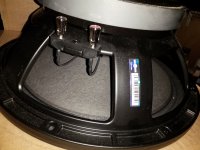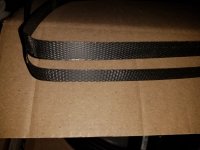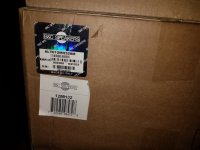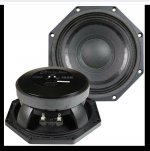I bought some B&C 12MH32s from a private sale and have some suspicions regarding their authenticity. The thing that concerns me is the packaging, specifically the tape used to seal the box and the banding around the inside folded cardboard. I've never seen a B&C driver packaged this way so I'm a bit nervous.
The boxes do look authentic compared to other B&C drivers I've purchased. There are matching holografic stickers with part and serial numbers on the boxes and drivers. The part about the driver which worries me is the spring loaded terminals compared to the ones in the stock picture from the B&C website showing they're faston terminals. A quick Fs measurement confirms Fs do be within 3 Hz of published spec before break-in, although on the lower side of the range. A high power sine sweep sounds very good, clean and no weird noises. Without comprehensive TSP measurements I won't know for sure. I just want to hear what you guys think.
Has anyone seen B&C drivers packaged this way before? Is this possibly a fake?
The boxes do look authentic compared to other B&C drivers I've purchased. There are matching holografic stickers with part and serial numbers on the boxes and drivers. The part about the driver which worries me is the spring loaded terminals compared to the ones in the stock picture from the B&C website showing they're faston terminals. A quick Fs measurement confirms Fs do be within 3 Hz of published spec before break-in, although on the lower side of the range. A high power sine sweep sounds very good, clean and no weird noises. Without comprehensive TSP measurements I won't know for sure. I just want to hear what you guys think.
Has anyone seen B&C drivers packaged this way before? Is this possibly a fake?
Attachments
If they sound good, no distortion, and the price was acceptable, just enjoy the music.
If you feel cheated, what can you do about it?
This may just have been interim packaging when plants were shifted from one place to another.
Or it is a very good fake, as the sound is acceptable to you.
Considering that drivers are not very high technology, I would either use them on dispose of them.
In this day and age, authenticity simply means high margins added by all in the food chain, most times the actual maker gets very little profit.
If you feel cheated, what can you do about it?
This may just have been interim packaging when plants were shifted from one place to another.
Or it is a very good fake, as the sound is acceptable to you.
Considering that drivers are not very high technology, I would either use them on dispose of them.
In this day and age, authenticity simply means high margins added by all in the food chain, most times the actual maker gets very little profit.
Oh please, you are worrying about the least important parameter.
Cardboard box "banding" indeed??????
As of your spring push terminals, they are way better and more expensive than cheap hollow riveted fastons, so I guess those sold by B&C are the fake ones 😉
Cardboard box "banding" indeed??????
As of your spring push terminals, they are way better and more expensive than cheap hollow riveted fastons, so I guess those sold by B&C are the fake ones 😉
I sort of agree with you there. I've had many obvious copies of famous drivers that were charming in their own way, sometimes with better attributes in some areas compared to their originals. This driver has under spider venting as most B&C in this category. The cone is pictured on B&C's website as PVA or latex coated but this driver isn't. Upon looking at recone kits, they aren't coated either so perhaps there was a production change or the incorrect picture was used. There is some doping of the cone around the VC which may be used to control breakup.
If they are actual fakes, my main issue is they are being passed off as the real thing and thati gets me steamed, mainly out of principal. Once I check TSPs I'll know more.
Another thought was these drivers were packaged for sale as oem replacement parts for another vendor. Either way I'm going to look into the situation, just so I can warn others and be the one who gets ripped off before they do. The SKU is also invalid for this model driver according to the b/w sticker outside the box when I googled it. There may be some gray market thing going on here.
The mid band of these drivers sounds clean and clear, which is where they're mainly being used, in the 100 to 600 hz range in FLH configuration. The Qts is .19 and the FR has a rising characteristic along with a mid band efficiency of over 100dB. We'll see if they can live up to their specs. The design concept is a modified Edgar tractrix from 90 Hz to 700 Hz. Its going to be a stretch for that much bandwidth but hornesp says its possible with the factory specs, so we'll see.
If they are actual fakes, my main issue is they are being passed off as the real thing and thati gets me steamed, mainly out of principal. Once I check TSPs I'll know more.
Another thought was these drivers were packaged for sale as oem replacement parts for another vendor. Either way I'm going to look into the situation, just so I can warn others and be the one who gets ripped off before they do. The SKU is also invalid for this model driver according to the b/w sticker outside the box when I googled it. There may be some gray market thing going on here.
The mid band of these drivers sounds clean and clear, which is where they're mainly being used, in the 100 to 600 hz range in FLH configuration. The Qts is .19 and the FR has a rising characteristic along with a mid band efficiency of over 100dB. We'll see if they can live up to their specs. The design concept is a modified Edgar tractrix from 90 Hz to 700 Hz. Its going to be a stretch for that much bandwidth but hornesp says its possible with the factory specs, so we'll see.
JM, I'm not worried about packaging as such. Just trying to look at all the clues whether they're real B&C drivers. I could care less if the packagjng has the word RIPOFF printed on it, as long as the driver itself functions to spec. Same goes for the spring terminals - I prefer them over fastons but they are a potential identifier of a fake vs genuine product. The only thing that I really worry about aside from the adherence to factory specs is the quality of adhesives and materials holding up. I've had the VC windings start to come apart on some of these knockoff drivers. Then if you wanted to recone them, a factory recone kit wouldn't fit either, so you end up having to redo the crossover as well if you can't find the exact substitute driver.Oh please, you are worrying about the least important parameter.
Cardboard box "banding" indeed??????
As of your spring push terminals, they are way better and more expensive than cheap hollow riveted fastons, so I guess those sold by B&C are the fake ones 😉
I've not use this particular B&C driver, but one that I do is available with either Faston or spring-loaded terminals. Checking with my supplier reveals that your driver is available in the UK with either fastening; I hope this helps allay your worries.JM, I'm not worried about packaging as such. Just trying to look at all the clues whether they're real B&C drivers. I could care less if the packagjng has the word RIPOFF printed on it, as long as the driver itself functions to spec. Same goes for the spring terminals - I prefer them over fastons but they are a potential identifier of a fake vs genuine product. The only thing that I really worry about aside from the adherence to factory specs is the quality of adhesives and materials holding up. I've had the VC windings start to come apart on some of these knockoff drivers. Then if you wanted to recone them, a factory recone kit wouldn't fit either, so you end up having to redo the crossover as well if you can't find the exact substitute driver.
True, but faking would cost way more than new IF faker had to exactly clone that expensive cast frame injection die, exact same cone, magnetic system (talking only about what´s visible to the naked eye), etc.
Not technically "impossible" (if B&C could do it, others can too), simply anti-economical, so killing the basic motivation behind faking: profit.
Same with labels, specially the holographic one.
There is a reason holographic images are used in ID papers, money, warranty certificates, etc. , and that is precisely the difficulty of faking them.
There is also the fact that making "one or a few" of anything is way more expensive than making a large run.
B&C will definitely recover money invested in 1-2 years .... will a faker sell that many in a short time?
Not technically "impossible" (if B&C could do it, others can too), simply anti-economical, so killing the basic motivation behind faking: profit.
Same with labels, specially the holographic one.
There is a reason holographic images are used in ID papers, money, warranty certificates, etc. , and that is precisely the difficulty of faking them.
There is also the fact that making "one or a few" of anything is way more expensive than making a large run.
B&C will definitely recover money invested in 1-2 years .... will a faker sell that many in a short time?
@ErnieM - was the banding and adhesive tape on the box unbranded as well? If so that gives me some relief. Whats weird is they used narrow tape on my boxes. The B&C stamped packing tape is almost double the width.
@MrKlinky - thats good to know they come in both versions. I appreciate you looking into that for me.
@MrKlinky - thats good to know they come in both versions. I appreciate you looking into that for me.
Interestingly (to me, anyway!), I had a similar experience with used BMS 4594 compression drivers a few years ago, but they proved to be genuine, and I simply could not imagine anybody pirating such a complicated low sales volume device anyway!
B&C spring terminals
(Generic photo on sales site!).
B&C spring terminals
(Generic photo on sales site!).
@JMFahey - That all makes perfect sense. The shocker for me was receiving several fake 8PE21s which had the hologram labels and identical baskets, magnets, etc. They looked like the real thing, but when measured they fell way short of their specs and didn't even match each other within 20% of Fs, Qts and efficiency thanks to unevenly magnetized motors. I pulled one apart and the VC gap not only had no copper in it, but was .125" wide. What was supposed to be a 98 dB/w driver was essentially 89 dB/w (the best one of the bunch). I notified B&C and they offered to pay for shipping two of the fakes to them. These drivers were purchased from ebay as NOS pieces.
I bought them in 2013. I think the boxes might still have some tape on them.
That's unfortunate about the 8PE21 copies...
The four drivers I bought all had lower fs but measured extremely close to each other. Hopefully you get something close to published or at least consistent between the two.
That's unfortunate about the 8PE21 copies...
The four drivers I bought all had lower fs but measured extremely close to each other. Hopefully you get something close to published or at least consistent between the two.
@MrKlinky - You would think that is the case. If the price is high enough, there's always a possibility for counterfeiting an item, especially if it shares components with other like items. There are multiple companies that sell similar looking drivers like some of the 8 inch B&Cs, mainly the popular ones ie 8ps21 and 8pe21.
Attachments
Thanks Ernie. That does help me alot.
Yeah, at this point I just need to get the TS parameters measured. That way I'll know for sure. Otherwise they do sound on point so far. I'll post my findings when I have them. I dont mind a lower Fs if the Vas and Qts aren't too high. The higher EBP and smooth rising response is what I'm mainly looking for.
Yeah, at this point I just need to get the TS parameters measured. That way I'll know for sure. Otherwise they do sound on point so far. I'll post my findings when I have them. I dont mind a lower Fs if the Vas and Qts aren't too high. The higher EBP and smooth rising response is what I'm mainly looking for.
😱 😱 😱@JMFahey - That all makes perfect sense. The shocker for me was receiving several fake 8PE21s which had the hologram labels and identical baskets, magnets, etc. They looked like the real thing, but when measured they fell way short of their specs and didn't even match each other within 20% of Fs, Qts and efficiency thanks to unevenly magnetized motors. I pulled one apart and the VC gap not only had no copper in it, but was .125" wide. What was supposed to be a 98 dB/w driver was essentially 89 dB/w (the best one of the bunch). I notified B&C and they offered to pay for shipping two of the fakes to them. These drivers were purchased from ebay as NOS pieces.
That means they are aware of the issue, seems to be from their end.
Eek is a proper response.
Take your future business elsewhere, in my opinion.
Eek is a proper response.
Take your future business elsewhere, in my opinion.
I genuinely loath counterfeit crap and patent infringement.
My grandfather designed the very first rotary piston engine before WW2. He was a teacher and shared the design prints with his students for educational purposes at a university in Traunstein, Germany... a few months later he received a letter from NSU offering to purchase the design dirt cheap, but he declined. When he finally had enough money to file for patents, during the whole process he then found an article in a German technical magazine about the "new" wankel engine, being touted as NSU's all new creation and invention. The concept and design was stolen since my grandfather didn't apply for the patent in time, having to wait for financial reasons. Long story short, Mazda then bought the rights and license to build it, so the rest is history. This is an honest to goodness story. He could have made alot of money from it had NSU not stolen it from him. To add insult to injury, the typical trouble with the apex seals common to Mazda's wankel design weren't in the original design by my grandfather. He had a better method of sealing the piston at the cylinder walls which NSU and Mazda cheaped out on.
Counterfeit crap costs companies alot of money. The Chinese have no respect for others, especially the US. Patent laws that don't seem to reach across the pond, which is why you see so much copied stuff on the internet. A lot of it is usually inferior junk, sometimes even dangerous and hazardous.
My grandfather designed the very first rotary piston engine before WW2. He was a teacher and shared the design prints with his students for educational purposes at a university in Traunstein, Germany... a few months later he received a letter from NSU offering to purchase the design dirt cheap, but he declined. When he finally had enough money to file for patents, during the whole process he then found an article in a German technical magazine about the "new" wankel engine, being touted as NSU's all new creation and invention. The concept and design was stolen since my grandfather didn't apply for the patent in time, having to wait for financial reasons. Long story short, Mazda then bought the rights and license to build it, so the rest is history. This is an honest to goodness story. He could have made alot of money from it had NSU not stolen it from him. To add insult to injury, the typical trouble with the apex seals common to Mazda's wankel design weren't in the original design by my grandfather. He had a better method of sealing the piston at the cylinder walls which NSU and Mazda cheaped out on.
Counterfeit crap costs companies alot of money. The Chinese have no respect for others, especially the US. Patent laws that don't seem to reach across the pond, which is why you see so much copied stuff on the internet. A lot of it is usually inferior junk, sometimes even dangerous and hazardous.
Wow - the Mazda rotary was invented by your grand father?! Was his name Wankel or that was misappropriated by NSU (what is NSU?) Sorry to hear that such an idea was stolen - in the US, public disclosure of an idea starts a clock ticking and requires one to file a patent invention disclosure within 12 months to “lay your stake in the ground” or risk losing rights to it.
My grandfather invented the concept and basic design of the rotary piston engine. Felix Wankel (who worked for NSU) stole the idea and was awarded the design patent in the early 30s. The engine wasn't put into production until the late 40s. The war time politics also added to this going wrong for my grandfather, since he wasn't a fan of the nazi party, so they didn't acknowledge his design and research work. When my father passed away, he had saved the dated and notarized concept drawings. Hitler stole alot of intellectual properties from all sorts of people (among many other things) during his rule. Many people were discredited in the academic and scientific community, especially if they didn't support the nazi party or if they weren't of German descendency. This is the honest to God truth.
I think some of the timelines are slightly mangled there as Wankel didn't start working for NSU until the 50s but filed his patent in 1929. Irony of course is that his engine design wasn't even used in cars. But if he has drawings pre-dating 1929 that would be worthy of a webpage.
Lovely concept, if a total thermodynamic failure.
Lovely concept, if a total thermodynamic failure.
- Home
- Loudspeakers
- Multi-Way
- Is this an authentic or counterfeit B&C driver?



